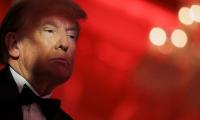Any discussion about the South Asia of the 1970s will remain incomplete unless we also discuss Afghanistan – the country which has suffered the most since that fateful decade.
The observations shared here are based on personal discussions this writer has had with Afghan friends belonging to both the Khalq and Parcham factions of the People’s Democratic Party of Afghanistan (PDPA). There were not hundreds but thousands of Afghan students studying in the Soviet Union in the 1980s, when I also happened to be there for a few years. Any inaccuracy here will be entirely this writer’s lapse of memory.
First, some background. British forces tried to colonize Afghanistan at least twice in the 19th century: in 1838 - 40 and then forty years later in 1878 – 80. Both attempts failed. In the early 20th century, Amir Amanullah Khan ruled from 1919 to 1929 and tried to modernize Afghanistan. A backlash and revolt against his liberal and progressive policies resulted in his forced abdication and a civil war. From 1933 to 1973, Afghanistan was ruled by King Zahir Shah who tried to maintain a good relationship with the Soviet Union and with other world powers.
The year 1973 was a turning point when Sardar Daoud Khan toppled his cousin and brother-in-law, King Zahir Shah, who was undergoing medical treatment in Italy. PDPA comrades claimed that Daoud Khan managed to take over power in Afghanistan with their help. The PDPA was a left-wing political party founded in 1965 by some pro-Soviet intellectuals and politicians such as Nur Muhamad Taraki and Babrak Karmal. This party had influence in the armed forces and intelligentsia who wanted to get rid of the kingdom, and establish a republic.
When the PDPA was founded in the 1960s, it already had differences of opinion among comrades in their approaches to socialism. For example, Taraki was a staunch communist who had spent years in British India, especially in Bombay (now Mumbai) where he befriended Indian communists who guided him through the theories of Marxism-Leninism. Taraki’s approach was more straightforward – to fight for socialism in Afghanistan and stage a revolution. Babrak Karmal was relatively moderate in his approach as he was trained by Mir Akbar Khyber, who was more grounded in Afghan realities than Taraki.
The differences in approaches led to a split in the PDPA in 1967 and the party was factionalized into the Khalq and Parcham sections. Both had their own infiltration strategies in the Afghan armed forces. When Hafizullah Amin joined the Khalq faction, thanks to his brilliant oratory and American education he was able to recruit more new comrades into the Khalq fold. Amin had studied at Columbia University and had been influenced by Marxist ideology there; now back in Afghanistan he was a young communist leader with backing in armed forces and in students alike.
One reason for the increasing left-wing influence in the armed forces was that hundreds – or maybe thousands – of the defence and security personnel had been trained by the Soviet Union and had developed a liking for the socialist revolutionary dream. Afghanistan had remained a most backward and poor country throughout the 20th century and its tribal and feudal culture and economy were abhorred by the young and old comrades who wanted to change all this with Soviet help. When Daoud took over, there was hope of a rapid transformation.
As it happens with Sardars, Daoud started dilly-dallying on reforms and introduced a constitution with a one-party presidential rule in January 1977, and established his National Revolutionary Party. At this turn of events, the PDPA developed its own agenda and started reorganizing by trying to merge the Khalq and Parcham factions. Mir Akbar Khyber facilitated this merger, but the difference in approache continued. When Daoud realized that the PDPA was getting stronger, he launched a crackdown and the first step was the assassination on April 17, 1978 of Mir Akbar Khyber who was just 53 years old but a widely respected and influential leader of the PDPA.
The PDPA accused Daoud for this murder, whereas the government blamed it on Gulbuddin Hikmatyar who was in Pakistan, and according to Daoud was conspiring against the Afghan government. Mir Akbar Khyber’s assassination triggered protests from the PDPA resulting in panic by Daoud who initiated a massive assault on left-wing activists and leaders. Most of the leaders of the PDPA were either arrested or had to go underground. Under these circumstances, it became a do-or die situation for the PDPA whose Khalq faction led by Hafizullah Amin asked his comrades in the Afghan armed forces to stage a coup.
April 27, 1978, was the eventful day when a section of the army led by Col Aslam Watanyar, and the air force led by Col Abdul Qadir invaded the presidential palace; and Daoud with most of his family was assassinated, much in the same fashion as had happened in Bangladesh with Mujib less than two years earlier. A new revolutionary council was formed with Taraki as chairman, Karmal as deputy chairman, and Amin as foreign minister. This was called the Saur Revolution, named after the Afghan month in which the coup was staged.
Afghanistan became the Democratic Republic of Afghanistan, with Nur Muhammad Taraki as president. Taraki was a hardliner and initiated his revolutionary reforms almost immediately such as land redistribution, women’s rights, ban on usury and bride prices, separation of religion from politics and the state, and many others. The reforms were good but there was no mechanism to enforce them. Most of Afghanistan had remained out of bounds for the central government for centuries. Local tribal heads, feudal lords, and religious leaders were the ones who actually commanded power in mostly rural Afghanistan.
Then the personality cult of Taraki that was initially developed and supported by Hafizullah Amin was challenged by him when Taraki started making decisions on his own without listening to Amin. The fact that the coup was initiated by the orders of Amin, made him think that he was the real mastermind of the revolution without whom Taraki wouldn’t be the president. Within 18 months after the coup, most of the Parcham-faction comrades had been ousted because they were in favour of a more gradual approach to revolution. Even the (then) USSR advised Amin and Taraki to slow down and not to antagonize the Parcham comrades and others.
In September 1979, Amin staged a countercoup and with his friends in the army arrested Taraki and declared himself the new leader of Afghanistan. Taraki was 62 years old and Amin was just 50, making him think that he was more energetic to lead the revolution. Taraki was killed in October 1979, which enraged the Soviet Union. There is evidence to suggest that Taraki had asked the USSR to intervene in Afghanistan to strengthen his government but Brezhnev, the Soviet leader, had politely declined. Now with Taraki gone and Amin on a rampage, there was a strong chance of a mass revolt and reversal of the revolution.
Finally, in the last week of December 1979, the Soviet forces crossed the border and the invasion of Afghanistan was complete. Hafizullah Amin was killed and Babrak Karmal of the Parcham faction who had been sent abroad as ambassador was installed as the new Afghan leader. The bloody saga that started with the murder of Mir Akbar Khyber in April 1978, took with it the lives of Daoud, Taraki, and Amin, all within a span of less than two years. In the last part of this series tomorrow, we will draw some conclusions.
To be continued
The writer holds a PhD from theUniversity of Birmingham, UK and works in Islamabad.
Email: mnazir1964@yahoo.co.uk
In July, President-elect Trump pledged to establish a US National Strategic Bitcoin Reserve
Lahore, city that is supposedly crown jewel of Pakistan, and certainly Punjab at a minimum
This relentless cycle begs question: could air pollution finally bring our countries together in meaningful dialogue?
Senior Punjab Minister Marriyum Aurangzeb said on Friday that it has turned into a “health crisis”
While local coal may appear cost-effective, its environmental and health impacts are far too severe
On Sunday, November 3, Lahore’s Air Quality Index hit a peak of 1173







